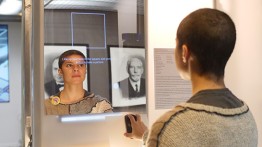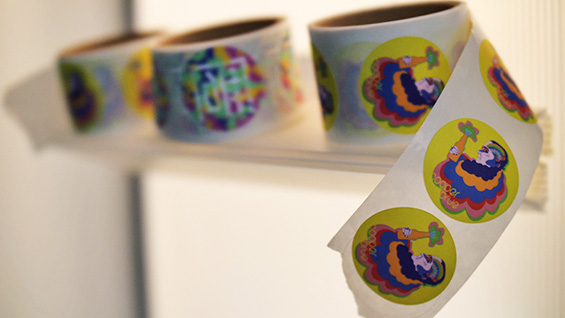2019 Shenzhen Biennale Features Cooper Students' Work
POSTED ON: February 12, 2020

Ariana Frietag with the prototype of "Hiding from the Eyes of the City"
A project developed by an interdisciplinary group of Cooper students last spring has made its way into the Shenzhen 2019 Bi-City Biennale of Urbanism/ Architecture, held in northeastern China, though it almost didn't make it there due to its perceived potential political ramifications. (In related news: four 2018 graduates of The Irwin S. Chanin School of Architecture also have work appearing in the biennale.) This is the second time in a row that Cooper students' work has appeared at the international urbanization-focused event. In 2017 Margaux Wheelock-Shew AR'18, along with Cheung Lun Jeremy Son, now in his fifth year at the school, and Nader Tehrani, the dean, co-designed a pavilion located outside the event's entrance.
This year's project developed out of a course the students took last fall entitled "Hiding from the Eyes of the City." Part of a series of interdisciplinary classes meant to motivate students to wrestle with ethical questions in their fields, the class set out to find ways to obfuscate facial-recognition software. Benjamin Aranda, an assistant professor of architecture teamed with Sam Keene, an associate professor of electrical engineering, to provide a forum to discuss who has the right to the city, is surveillance ever acceptable, and what are the long-term implications of software that can identify and track individuals' movements.

The students employed a facial-recognition system that assigned numerals to individual faces. Once that information was inputted to the system, they developed ways to render the data useless, so that people could move through space without fear of being identified. They eventually hit upon a method using simple stickers applied to the face that outwitted the ID software.
The group's work was accepted into the prestigious Shenzhen Biennale, the most visited architecture biennial in the world according to ArchDaily. However, when the project was to be mounted, the Chinese Cultural Bureau felt its content too political in nature to be part of the festival, said Professor Keene. Nonetheless, the biennial's curators found a way to include the Cooper project: they asked the team to collaborate on a set of information kiosks at the fair's entrance. Working remotely with the curators and their technical team, they worked to make the facial-recognition system—and the opportunity to opt out of it—a part of the information booths.
"For reasons we never really entirely understood," said Professor Keene, "the Cultural Bureau did not decide to censor this as it was considered part of the Biennial ‘infrastructure’ and not one of the exhibits."
The chief curator of the "Eyes on the City" section of the biennial, Carlo Ratti, notes that China is at the forefront of facial-recognition technology, though it is only a matter of time that other countries will be deploying such software on a regular basis. In an interview with DesignBoom, Ratti said,"...in the biennale, we have chosen to use a facial recognition system for registration which offers the choice to opt-out and not be recognized by the system, also by wearing a special mark developed in collaboration with The Cooper Union. This expresses a belief that I share: key decisions about cities and society should rest in the hands of the citizens.
The Shenzhen Biennale will run until March 2020.




